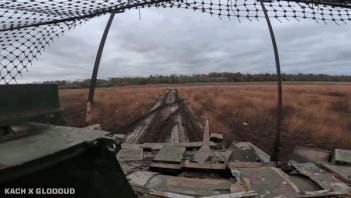On or just before Oct. 26, a trio of the Ukrainian army’s best American-made vehicles—a pair of M-2 Bradley fighting vehicles and an M-1 Abrams tank—rolled through a breach in Russian fortifications just south of the tiny village of Novyi Put in western Russia’s Kursk Oblast.
As a Ukrainian drone observed from overhead, the Bradleys led the way, popping smoke for cover and blasting away with their 25-millimeter autocannons and TOW anti-tank missiles. The Abrams followed behind, lending weight to the rapid assault.
Brushing off Russian fire, the three vehicles barreled toward a Russian-held treeline just north of the border. The fall-off in shooting from the Russian positions, evident in the drone’s feed as well as in videos shot by the Ukrainian vehicle crews, is telling: the Ukrainians were the victors in the skirmish.
But what was the point? Novyi Put is 250 miles from the locus of Russia’s 33-month wider war on Ukraine around Kurakhove in eastern Ukraine’s Donetsk Oblast. While the Ukrainian army’s elite 47th Mechanized Brigade—the sole user of Ukraine’s M-2s and M-1s—wins meaningless fights outside a Russian border village, a battered Ukrainian air assault brigade, the 79th, is barely holding onto its defensive line in the town of Illinka, six miles south of Kurakhove.
If Illinka falls, it’s likely Kurakhove will fall, too. If Kurakhove falls, the Russians could pinch half a dozen Ukrainian brigades into a salient in southern Donetsk Oblast. Forcing a salient—or a “bag,” to borrow Ukrainian journalist Stanislav Aseyev’s term—is a classic battlefield tactic, and one the Russian army in Ukraine has used to devastating effect in recent months.
“The Russians continue to successfully use the ‘bag’ tactics, bypassing our positions on three sides and leaving a narrow ‘throat’ for retreat,” Aseyev explained. “As a result, even in combat-ready units, encirclement panic often begins, which leads to the withdrawal of troops.”
If the Ukrainians lose southern Donetsk, they might have no choice but to make a desperate last stand in Pokrovsk, a fortress city 17 miles north of Kurakhove. And if they lose Pokrovsk, their whole defensive line in eastern Ukraine could unravel.
The stakes in the east are enormous; the stakes in Kursk Oblast are ambiguous at best. A strong Ukrainian force with many of Kyiv’s best foreign-made vehicles invaded Kursk in early August and quickly captured hundreds of square miles; the recent 47th Mechanized Brigade raid is a corollary to this main Ukrainian effort.
The invasion has been an impressive tactical achievement for the overstretched Ukrainian forces, but the wider strategic implications are unclear.
If Ukraine was trying to draw significant Russian forces into Kursk in order to deplete the Russian forces in eastern Ukraine, it failed: Russia has been able to counterattack in Kursk without slowing its offensive in Donetsk.
If Ukraine aims to hold part of Kursk in order to trade it for parts of Russian-occupied Ukraine during any future peace negotiations, it’s apparently betting it won’t lose more Ukrainian soil as a consequence of the invasion than it gains in the possible negotiations. That’s not a safe bet.
Weighing the undeniable value of Illinka, Kurakhove and Pokrovsk against the debatable value of Kursk, at least one Ukrainian trooper has questioned the wisdom of the ongoing Ukrainian operations in the latter.
“It’s very hard to accept and understand the advantage of being here in the fields of Kursk Oblast while losing cities,” wrote Kriegsforcher, a Ukrainian drone operator. By that thinking, those Bradleys and Abrams skirmishing in Kursk should be in eastern Ukraine, instead—helping hold back a relentless Russian offensive.
Read the full article here





